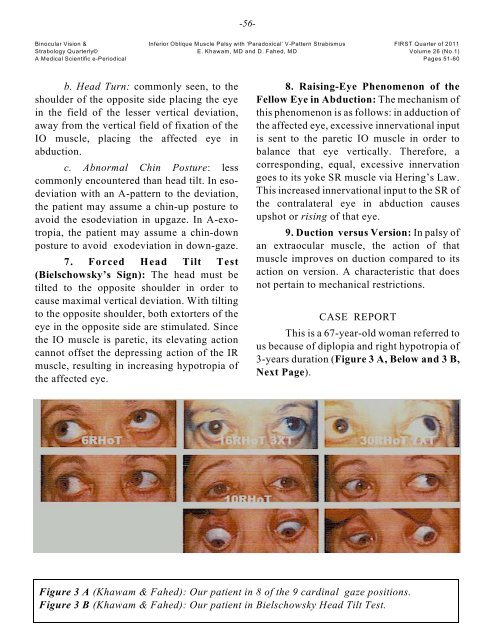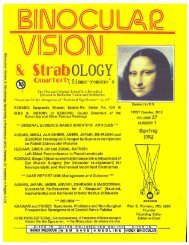Correspondence - ICO Library
Correspondence - ICO Library
Correspondence - ICO Library
Create successful ePaper yourself
Turn your PDF publications into a flip-book with our unique Google optimized e-Paper software.
-56-<br />
Binocular Vision & Inferior Oblique Muscle Palsy with ‘Paradoxical’ V-Pattern Strabismus FIRST Quarter of 2011<br />
Strabology Quarterly© E. Khawam, MD and D. Fahed, MD Volume 26 (No.1)<br />
A Medical Scientific e-Periodical Pages 51-60<br />
b. Head Turn: commonly seen, to the<br />
shoulder of the opposite side placing the eye<br />
in the field of the lesser vertical deviation,<br />
away from the vertical field of fixation of the<br />
IO muscle, placing the affected eye in<br />
abduction.<br />
c. Abnormal Chin Posture: less<br />
commonly encountered than head tilt. In esodeviation<br />
with an A-pattern to the deviation,<br />
the patient may assume a chin-up posture to<br />
avoid the esodeviation in upgaze. In A-exotropia,<br />
the patient may assume a chin-down<br />
posture to avoid exodeviation in down-gaze.<br />
7. Forced Head Tilt Test<br />
(Bielschowsky’s Sign): The head must be<br />
tilted to the opposite shoulder in order to<br />
cause maximal vertical deviation. With tilting<br />
to the opposite shoulder, both extorters of the<br />
eye in the opposite side are stimulated. Since<br />
the IO muscle is paretic, its elevating action<br />
cannot offset the depressing action of the IR<br />
muscle, resulting in increasing hypotropia of<br />
the affected eye.<br />
8. Raising-Eye Phenomenon of the<br />
Fellow Eye in Abduction: The mechanism of<br />
this phenomenon is as follows: in adduction of<br />
the affected eye, excessive innervational input<br />
is sent to the paretic IO muscle in order to<br />
balance that eye vertically. Therefore, a<br />
corresponding, equal, excessive innervation<br />
goes to its yoke SR muscle via Hering’s Law.<br />
This increased innervational input to the SR of<br />
the contralateral eye in abduction causes<br />
upshot or rising of that eye.<br />
9. Duction versus Version: In palsy of<br />
an extraocular muscle, the action of that<br />
muscle improves on duction compared to its<br />
action on version. A characteristic that does<br />
not pertain to mechanical restrictions.<br />
CASE REPORT<br />
This is a 67-year-old woman referred to<br />
us because of diplopia and right hypotropia of<br />
3-years duration (Figure 3 A, Below and 3 B,<br />
Next Page).<br />
Figure 3 A (Khawam & Fahed): Our patient in 8 of the 9 cardinal gaze positions.<br />
Figure 3 B (Khawam & Fahed): Our patient in Bielschowsky Head Tilt Test.









